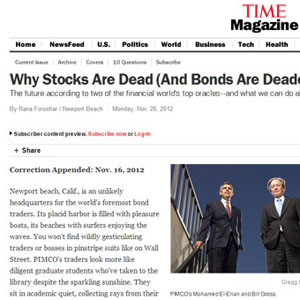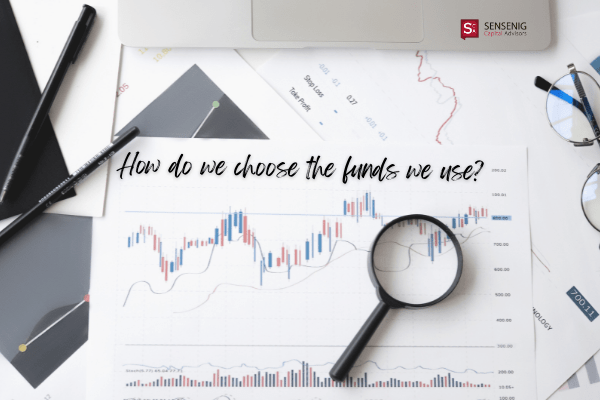The unusually strong performance of US stocks in 2013 was a welcome surprise for investors who are following a simple buy-and-hold strategy and a source of exasperation for many professionals caught flatfooted by the steady rise in share prices.
 It was the best year for the S&P 500 Index since 1997, with a total return in excess of 32%. The size and value dimensions were even more rewarding: 2013 was the best calendar year since inception for the DFA U.S. Large Cap Value Portfolio, while the DFA U.S. Micro Cap Portfolio had its second-best performance in 32 years of operation.
It was the best year for the S&P 500 Index since 1997, with a total return in excess of 32%. The size and value dimensions were even more rewarding: 2013 was the best calendar year since inception for the DFA U.S. Large Cap Value Portfolio, while the DFA U.S. Micro Cap Portfolio had its second-best performance in 32 years of operation.
To some experts, it wasn’t supposed to look like this. A Barron’s cover story appearing in November 2012 warned investors to “get ready for the recession of 2013.” The title of a Time article on the outlook for financial markets that same month shouted, “Why Stocks Are Dead” in oversize type. A prominent economic forecaster who predicted the downturn in 2008 suggested that four elements—stagnating US economic growth, the European debt crisis, a slump in emerging markets, and military conflict in the Middle East—could combine and lead to a “superstorm.”
Another prognosticator—and longtime Forbes columnist—ticked off a long list of worries, including a new wave of housing foreclosures, persistent government deficits, weak consumer spending, high unemployment, and unsustainable corporate profit margins. His prediction for 2013: “the S&P 500 Index drops to 800, a 42% decline.” Others fretted about a deepening slump in China that could drag the rest of the world down with it.
Detroit’s bankruptcy filing in July—the largest American city to do so—and the acrimonious debate over public finances in many cities and states suggested to some that a tectonic shift in municipal finance was underway with worrisome consequences. One prominent Wall Street researcher observed that “the aftershocks of the largest municipal bankruptcy in US history will be staggering, and Detroit will set important precedents.”
Individual and professional investors alike braced themselves throughout the year for a sharp selloff that never materialized. At times, the perverse reaction to rising prices was not delight but apprehension of an even steeper decline to come. On March 5, 2013, for example, the Dow Jones Industrial Average finally eclipsed its previous record of 14164.53, set in October 2007. But the Financial Times reported that the prevailing mood among veteran New York Stock Exchange floor traders was “more anxious than joyful.”
Month after month, a Greek chorus of financial journalists recycled the same arguments we have heard regularly for the past several years: Economic growth is well below average, stocks are expensive relative to earnings, corporate profit margins are historically high and can only come down, earnings growth is too weak, asset prices have been artificially inflated by an expansive monetary policy, and so on. A sample of headlines that might have unsettled investors appears below.
| January 12 | “Rebirth of Equities Ain’t Necessarily So,” Financial Times |
| February 8 | “Scant Pickup in Economic Growth Seen for 2013,” Wall Street Journal |
| March 7 | “Stock Markets Defy Economic Woes,” Financial Times |
| April 2 | “Lesser Expectations: Earnings Hopes Dim for First Quarter,” USA Today |
| May 18 | “Stock Market Optimism on This Scale Hard to Explain,” Financial Times |
| July 7 | “As Investors Rush in, Stocks Are Sending Warning Signals,” Wall Street Journal |
| August 24 | “Lofty Profit Margins Hint at Pain to Come for U.S. Shares,” Wall Street Journal |
| September 18 | “Profits Boost Needed for Wall Street’s Equities Run,” Michael Mackenzie, Financial Times |
| October 7 | “Get Ready For a Drop in Stock Prices,” Shefali Anand, Wall Street Journal |
| November 16 | “Is This a Bubble?” Joe Light, Wall Street Journal |
With so many economic hobgoblins to frighten them, many investors found it easy to dismiss more positive developments as unsustainable or irrelevant. Auto sales, for example, have been surprisingly strong in recent years, but investors could find plausible reasons for caution in 2013. A New York Times financial reporter observed, “After steady increases for decades, Americans are driving less. … Walkable cities are growing faster than suburbs. And wherever people happen to move, they are buying smaller, more fuel-efficient cars. … All this means that autos—one of the biggest industries in the United States—will not soon regain the explosive growth of the early 2000s.”
Some Americans are indeed buying more fuel-efficient cars; electric-only Tesla luxury sedans are popping up in driveways in tony neighborhoods across the country. But many other Americans are eagerly signing contracts for powerful full-size pickup trucks; light-duty truck sales were up roughly 20% through November, and the Ford F-150 continues to be the best-selling vehicle in America by a substantial margin. Last year turned out to be a rewarding one for shareholders of most auto manufacturers and suppliers as well.
Selected Automotive Stocks: 1-Year Total Return as of December 31, 2013
| Tesla Motors (TSLA) | 344.14% |
| Visteon (VC) | 74.32% |
| Johnson Controls (JCI) | 69.84% |
| Magna Intl (MGA) | 66.61% |
| General Motors (GM) | 41.76% |
| Paccar (PCAR) | 34.64% |
| Cummins (CMI) | 32.18% |
| Ford Motor (F) | 22.24% |
Source: Morningstar (www.morningstar.com), accessed January 2, 2014
What can investors learn from this year’s market behavior? Most of us accept the idea that predicting the future is difficult. And predicting how other investors will respond to unpredictable events is harder still. But, for some of us, the temptation to engage in such efforts is irresistible. If only we could do so, we could be so much wealthier, have the satisfaction of outwitting other clever market participants, and make ourselves more attractive to members of the opposite sex. But results from this past year tell us we should be skeptical of our ability—or anyone else’s—to do this well enough to outperform a simple buy-and-hold strategy. When investors are studying the long-run record of US stock market returns several years from now, we suspect many of them will find it difficult to recall exactly what it was that they were so worried about and discouraged them from pursuing the capital market rewards that were there for the taking.
References:
“Are We Headed for a Recession?” Barron’s, November 12, 2012.
Rana Foroohar, “Why Stocks Are Dead and Bonds Are Deader,” Time, November 26, 2012.
“Roubini: Perfect Storm or Not, 2013 Will Be Bumpy, Risky,” Moneynews, November 18, 2012.
A. Gary Shilling, “Prepare for a Market Plunge,” Forbes, January 21, 2013.
Meredith Whitney, “Detroit May Start a Wave of Municipal Bankruptcies,” Financial Times, July 24, 2013.
Adam Davidson, “What’s it Going to Be, 2013?,” New York Times, January 6, 2013.
Average Annual Total Returns as of 12/31/13
| 1yr | 5yr | 10yr | Expense Ratio 1 | |
| DFA U.S. Large Cap Value Portfolio | 40.32 | 21.02 | 8.88 | 0.27% |
| DFA U.S. Micro Cap Portfolio | 45.06 | 22.78 | 9.29 | 0.52% |
Performance data shown represents past performance and is no guarantee of future results. Current performance may be higher or lower than the performance shown. The investment return and principal value of an investment will fluctuate so that an investor’s shares, when redeemed, may be worth more or less than their original cost. To obtain performance data current to the most recent month- end, visit www.dimensional.com.
1. Expense ratios as of 10/31/12.
Small cap securities are subject to greater volatility than those in other asset categories. Sector-specific investments can also increase these risks. These risks are described in the Principal Risks section of the prospectus.



